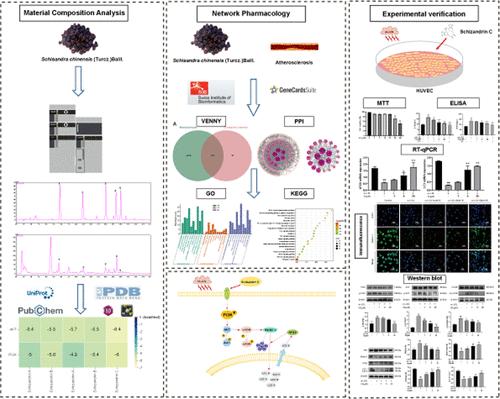Our official English website, www.x-mol.net, welcomes your
feedback! (Note: you will need to create a separate account there.)
Exploring the Molecular Mechanism of Schisandrin C for the Treatment of Atherosclerosis via the PI3K/AKT/mTOR Autophagy Pathway
ACS Omega ( IF 3.7 ) Pub Date : 2024-07-16 , DOI: 10.1021/acsomega.4c03738 Hong Duan 1, 2 , Han Li 1, 2 , Tianyi Liu 1 , Yuan Chen 1, 2 , Mengmeng Luo 1, 2 , Ying Shi 1, 2 , Jing Zhou 1, 2 , Marwan M A Rashed 1 , Kefeng Zhai 1, 2 , Lili Li 3 , Zhaojun Wei 4
ACS Omega ( IF 3.7 ) Pub Date : 2024-07-16 , DOI: 10.1021/acsomega.4c03738 Hong Duan 1, 2 , Han Li 1, 2 , Tianyi Liu 1 , Yuan Chen 1, 2 , Mengmeng Luo 1, 2 , Ying Shi 1, 2 , Jing Zhou 1, 2 , Marwan M A Rashed 1 , Kefeng Zhai 1, 2 , Lili Li 3 , Zhaojun Wei 4
Affiliation

|
Atherosclerosis (AS) is a common cardiovascular disease that poses a major threat to health. Schisandra chinensis is a medicinal and edible plant that is commonly used to treat cardiovascular diseases. In this paper, HPLC was used to detect and analyze 5 different components in Schisandra chinensis. Network pharmacological predictions highlight the PI3K/AKT/mTOR pathway as an important pharmacological pathway. The effective ingredient Schisandrin C was screened by the molecular docking technique. ox-LDL-induced HUVECs were used to construct the atherosclerosis model for further experimental verification. The results showed that Schisandrin C interfered with the PI3K/AKT/mTOR autophagy pathway. This study lays a foundation for the further application of Schisandrin C in the prevention and treatment of atherosclerosis in the future.
中文翻译:

探讨五味子C通过PI3K/AKT/mTOR自噬途径治疗动脉粥样硬化的分子机制
动脉粥样硬化(AS)是一种常见的心血管疾病,对健康构成重大威胁。五味子是一种药食两用植物,常用于治疗心血管疾病。本文采用高效液相色谱法对五味子中的5种不同成分进行检测分析。网络药理学预测强调 PI3K/AKT/mTOR 通路是一条重要的药理学通路。采用分子对接技术筛选有效成分五味子C。 ox-LDL诱导的HUVEC用于构建动脉粥样硬化模型以供进一步的实验验证。结果表明五味子C干扰PI3K/AKT/mTOR自噬通路。该研究为今后进一步应用五味子C防治动脉粥样硬化奠定了基础。
更新日期:2024-07-16
中文翻译:

探讨五味子C通过PI3K/AKT/mTOR自噬途径治疗动脉粥样硬化的分子机制
动脉粥样硬化(AS)是一种常见的心血管疾病,对健康构成重大威胁。五味子是一种药食两用植物,常用于治疗心血管疾病。本文采用高效液相色谱法对五味子中的5种不同成分进行检测分析。网络药理学预测强调 PI3K/AKT/mTOR 通路是一条重要的药理学通路。采用分子对接技术筛选有效成分五味子C。 ox-LDL诱导的HUVEC用于构建动脉粥样硬化模型以供进一步的实验验证。结果表明五味子C干扰PI3K/AKT/mTOR自噬通路。该研究为今后进一步应用五味子C防治动脉粥样硬化奠定了基础。






























 京公网安备 11010802027423号
京公网安备 11010802027423号